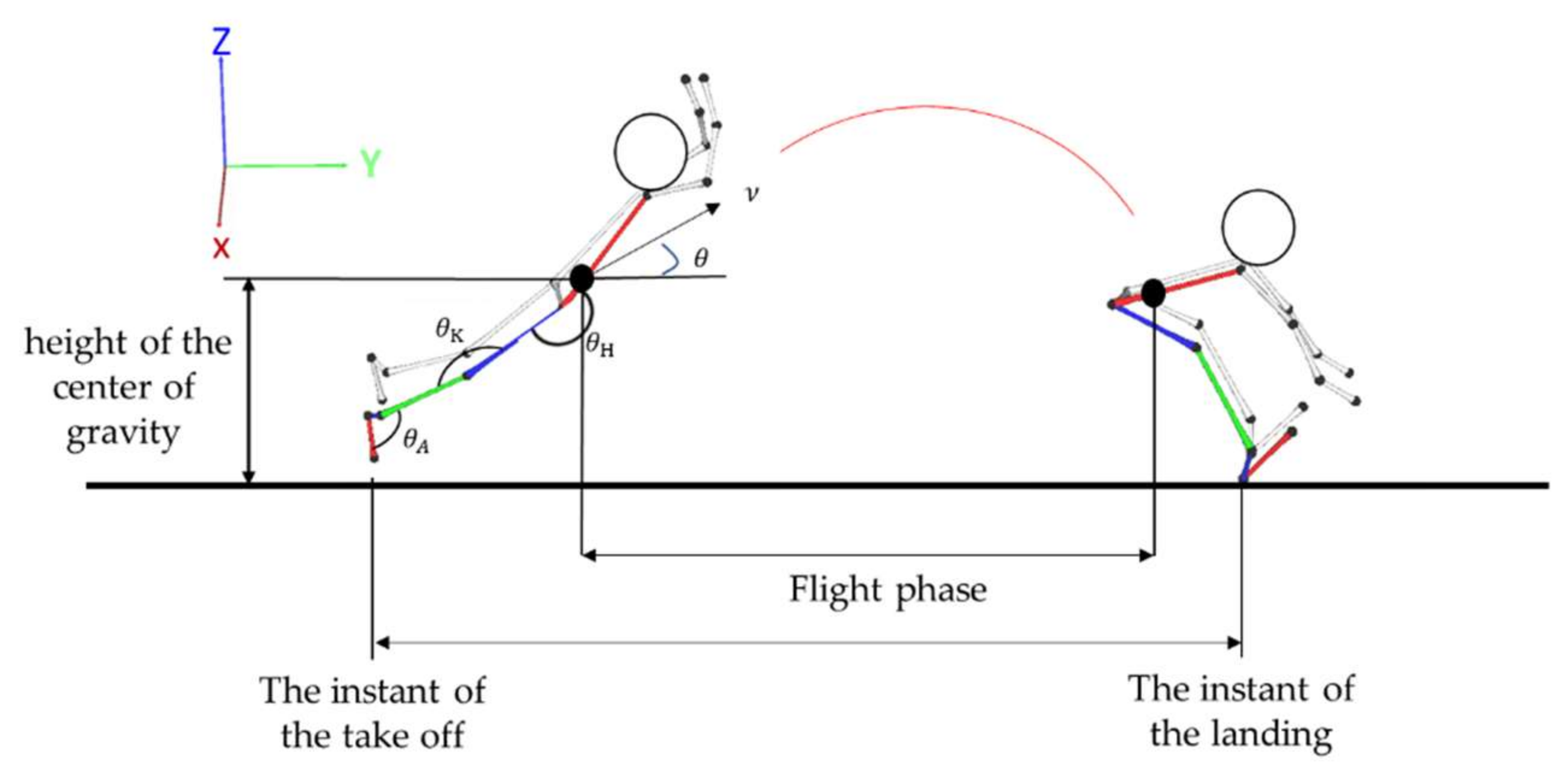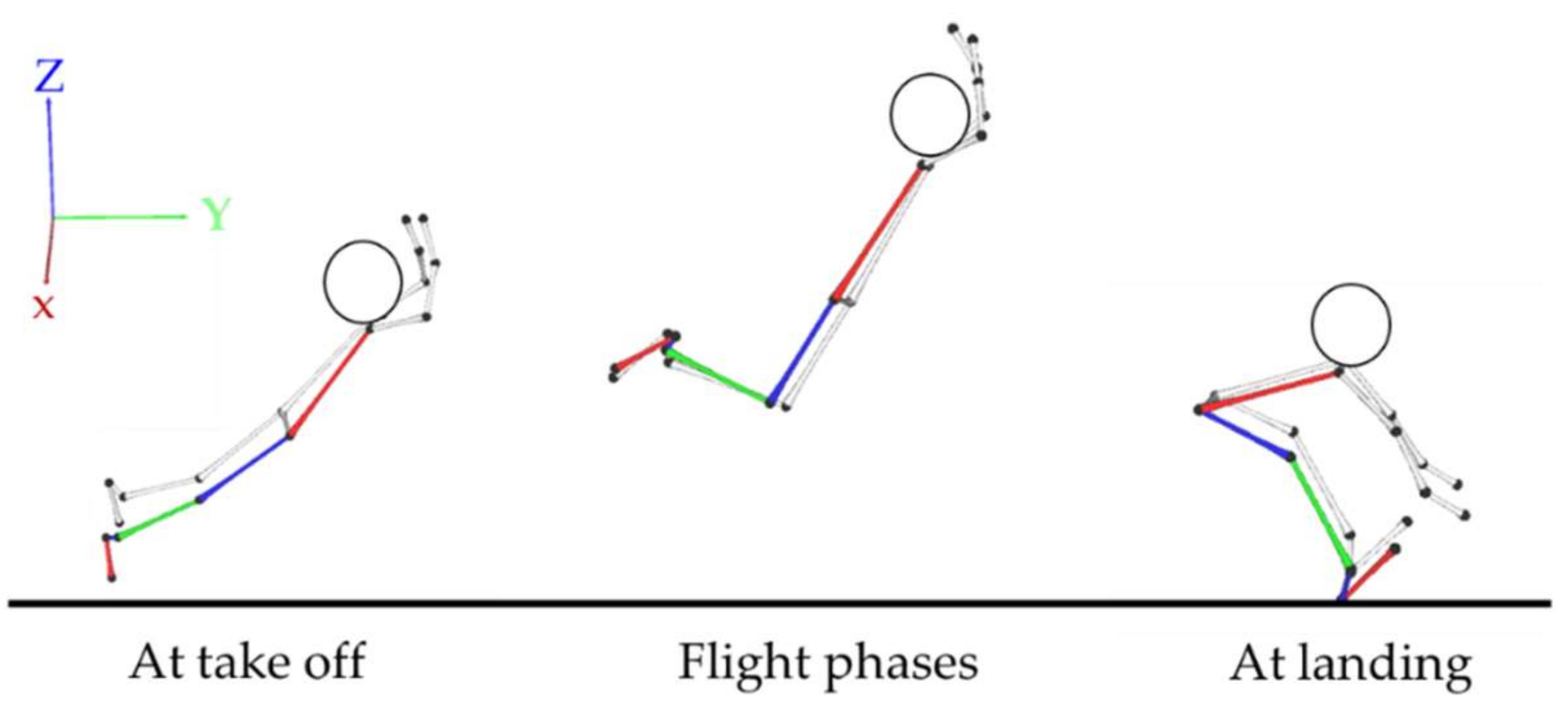The Effect of an 8-Week Rope Skipping Intervention on Standing Long Jump Performance
Abstract
:1. Introduction
2. Materials and Methods
2.1. Participants
2.2. Equipments and Data Collection
2.3. Data Processing
2.4. Statistical Analysis
3. Results
4. Discussion
5. Conclusions
Author Contributions
Funding
Institutional Review Board Statement
Informed Consent Statement
Acknowledgments
Conflicts of Interest
References
- Zhou, H.; Yu, P.; Thirupathi, A.; Liang, M. How to Improve the Standing Long Jump Performance? A Mininarrative Review. Appl. Bionics Biomech. 2020, 2020, 8829036. [Google Scholar] [CrossRef] [PubMed]
- Mackala, K.; Stodolka, J.; Siemienski, A.; Čoh, M. Biomechanical analysis of standing long jump from varying starting positions. J. Strength Cond. Res. 2012, 27, 2674–2684. [Google Scholar] [CrossRef] [PubMed]
- Lorger, M.; Hraski, M.; Hraski, Ž. The Effects of Motor Learning on Results of Standing Long Jump Performed by Female Students. Sport Sci. 2012, 5, 27–31. [Google Scholar]
- Partavi, S. Effects of 7 weeks of rope-jump training on cardiovascular endurance, speed, and agility in middle school student boys. Sport Sci. 2013, 6, 40–43. [Google Scholar]
- Bruce, O.L.; Ramsay, M.; Kennedy, G.; Edwards, W.B. Lower-limb joint kinetics in jump rope skills performed by competitive athletes. Sports Biomech. 2020, 1–14. [Google Scholar] [CrossRef]
- Yang, X.; Lee, J.; Gu, X.; Zhang, X.; Zhang, T. Physical Fitness Promotion among Adolescents: Effects of a Jump Rope-Based Physical Activity Afterschool Program. Children 2020, 7, 95. [Google Scholar] [CrossRef]
- Lorke, N.; Keller, S.; Rein, R.; Zedler, M.; Drescher, C.; Weil, P.; Schwerhoff, M.; Braunstein, B. Speed Rope Skipping-Performance and Coordination in a Four-Limb Task. J. Mot. Behav. 2022, 1–14. [Google Scholar] [CrossRef]
- Malar, S.; Maniazhagu, D. Effect of Circuit Training Combined with Speed Agility Quickness Drills and Jump Rope Drills on Agility. Asian J. Appl. Sci. Technol. (AJAST) 2022, 6, 111–121. [Google Scholar] [CrossRef]
- Shkola, O.; Andriushchenko, T.; Zhamardiy, V.; Dubovoi, O.; Andreiev, P. Rope skipping as a means of increasing students’ physical activity. JETT 2022, 13, 301–309. [Google Scholar]
- Miyaguchi, K.; Sugiura, H.; Demura, S. Possibility of Stretch-Shortening Cycle Movement Training Using a Jump Rope. J. Strength Cond. Res. 2014, 28, 700–705. [Google Scholar] [CrossRef]
- Trecroci, A.; Cavaggioni, L.; Caccia, R.; Alberti, G. Jump rope training: Balance and motor coordination in preadolescent soccer players. J. Sports Sci. Med. 2015, 14, 792. [Google Scholar] [PubMed]
- Turgut, E.; Çolakoğlu, F.F.; Güzel, N.A.; Karacan, S.; Baltacı, G. Effects of weighted versus standard jump rope training on physical fitness in adolescent female volleyball players: A randomized controlled trial. Fiz. Rehabil. 2016, 27, 108–115. [Google Scholar] [CrossRef] [Green Version]
- Mullur, K.V.M.; Jyoti, D.M. The impact of jump rope exercises on the body mass index of 12 to 16 years school children. Int. J. Physiol. Nutr. Phys. Educ. 2019, 4, 133–135. [Google Scholar]
- Hraski, M.; Hraski, Ž.; Mrakovi, S.; Horvat, V. Relation between Anthropometric Characteristics and Kinematic Parameters which Influence Standing Long Jump Efficiency in Boys and Adolescents. Coll. Antropol. 2015, 30, 47–55. [Google Scholar]
- Hickox, L.J.; Ashby, B.M.; Alderink, G.J. Exploration of the validity of the two-dimensional sagittal plane assumption in modeling the standing long jump. J. Biomech. 2016, 49, 1085–1093. [Google Scholar] [CrossRef] [PubMed]
- Wang, D.; Zhu, T.; Zhou, C.; Chang, Y.K. Aerobic exercise training ameliorates craving and inhibitory control in methamphetamine dependencies: A randomized controlled trial and event-related potential study. Psychol. Sport Exerc. 2017, 30, 82–90. [Google Scholar] [CrossRef]
- Swain, D.P.; Leutholtz, B.C. Heart rate reserve is equivalent to% VO2 reserve, not to% VO2max. Med. Sci. Sports Exerc. 1997, 29, 410–414. [Google Scholar] [CrossRef]
- Berger, B.G.; Darby, L.A.; Zhang, Y.; Owen, D.R.; Tobar, D.A. Mood alteration after 15 minutes of preferred intensity exercise: Examining heart rate, perceived exertion, and enjoyment. J. Sport Behav. 2016, 39, 3–21. [Google Scholar]
- Matsuura, H.; Mukaino, M.; Otaka, Y.; Kagaya, H.; Aoshima, Y.; Suzuki, T.; Inukai, A.; Hattori, E.; Ogasawara, T.; Saitoh, E. Validity of simplified, calibration-less exercise intensity measurement using resting heart rate during sleep: A method-comparison study with respiratory gas analysis. BMC Sports Sci. Med. Rehabil. 2019, 11, 1–8. [Google Scholar] [CrossRef]
- Ho, W.H.; Shiang, T.Y.; Lee, C.C.; Cheng, S.Y. Body segment parameters of young Chinese mean determined with Magnetic Resonance Imaging. Med. Sci. Sports Exerc. 2013, 45, 1759–1766. [Google Scholar] [CrossRef] [Green Version]
- Wakai, M.; Linthorne, N.P. Optimum take-off angle in the standing long jump. Hum. Mov. Sci. 2005, 24, 81–96. [Google Scholar] [CrossRef] [PubMed] [Green Version]
- Szerdiova, L.; Simsik, D.; Dolna, Z. Assessment of kinematics of sportsmen performing standing long jump in 2 different dynamical conditions. Metrol. Meas. Syst. 2012, 19, 85–94. [Google Scholar] [CrossRef] [Green Version]
- Cohen, J. Statistical Power Analysis for the Behavioral Sciences, 2nd ed.; Hillsdale, N.J., Ed.; Lawrence Erlbaum Associates: New York, NY, USA, 1988. [Google Scholar]
- Miyaguchi, K.; Demura, S.; Omoya, M. Relationship Between Jump Rope Double Unders and Sprint Performance in Elementary Schoolchildren. J. Strength Cond. Res. 2015, 29, 3229–3233. [Google Scholar] [CrossRef] [PubMed]
- Grosser, M.; Starischka, S. Test de la Condición Física; Martínez Roca: Barcelona, Spain, 1988. [Google Scholar]
- Malina, R.M.; Bouchard, C.; Bar-Or, O. Growth, Maturation, and Physical Activity, 2nd ed.; Human Kinetics Books: Champaign, IL, USA, 2004. [Google Scholar]
- Haywood, K.M. Life Span Motor Development, 2nd ed.; Human Kinetics: Champaign, IL, USA, 1993. [Google Scholar]
- Payne, V.G.; Isaacs, L.D. Human Motor Development: A Lifespan Approach, 5th ed.; Mayfield: Mountain View, CA, USA, 2002. [Google Scholar]
- Wen-Lan, W.; Jia-Roung, W.; Wai-Ting, L.; Gwo-Jaw, W. Biomechanical analysis of the standing long jump. Biomed. Engin. Appl. Basis Comm. 2003, 15, 186–192. [Google Scholar]


| Item | Duration (min) | Training Content |
|---|---|---|
| Warm-up Exercises | 10 | 800-m jogging and dynamic stretching |
| Double-Leg Jump | 1 |
|
| Take a break | 1 | heart rate had decreased to 120 beats/minute at the rest interval |
| Single-Leg Jump (right foot) | 1 |
|
| Take a break | 1 | heart rate had decreased to 120 beats/minute at the rest interval |
| Single-Leg Jump (left foot) | 1 |
|
| Take a break | 1 | heart rate had decreased to 120 beats/minute at the rest interval |
| Side to Side and Front to Back Jumps | 1 |
|
| Take a break | 1 | heart rate had decreased to 120 beats/minute at the rest interval |
| Alternating Leg Jump Rope | 1 |
|
| Take a break | 1 | heart rate had decreased to 120 beats/minute at the rest interval |
| Cool-down Exercises | 10 | Static Stretching |
| T1 | T2 | z | d | Effect Size | Power | |
|---|---|---|---|---|---|---|
| Performance of the standing long jump | ||||||
| Standing long jump distance (m) | 2.34 ± 0.18 | 2.51 ± 0.17 | −2.271 * | 0.97 | 0.94 | |
| The instant of the take off | ||||||
| Velocity of the center of gravity (m/s) | 3.39 ± 0.30 | 3.69 ± 0.30 | −2.830 ** | 1.00 | large | 0.95 |
| Angle of the center of gravity (deg) | 32.60 ± 4.60 | 30.20 ± 3.28 | −2.411 * | 0.59 | medium | 0.56 |
| Height of the center of gravity (m) | 86.27 ± 6.71 | 84.47 ± 6.37 | −1.363 | 0.27 | small | 0.17 |
| Hip joint (deg) | 159.08 ± 10.90 | 159.01 ± 9.18 | −0.245 | 0.01 | - | 0.05 |
| Knee joint (deg) | 160.78 ± 8.80 | 161.11 ± 8.17 | −0.245 | 0.04 | - | 0.05 |
| Ankle joint (deg) | 115.94 ± 23.35 | 121.92 ± 18.29 | −1.083 | 0.28 | low | 0.17 |
| Flight phase | ||||||
| Flight time (s) | 0.45 ± 0.04 | 0.45 ± 0.04 | −0.633 | 0.00 | - | 0.05 |
| The instant of the landing | ||||||
| Velocity of the center of gravity (m/s) | 3.62 ± 0.28 | 3.82 ± 0.25 | −2.132 * | 0.75 | medium | 0.77 |
| Angle of the center of gravity (deg) | −38.51 ± 5.80 | −38.06 ± 3.91 | −0.035 | 0.09 | - | 0.06 |
| Height of the center of gravity (m) | 57.88 ± 7.07 | 62.51 ± 7.11 | −1.293 | 0.65 | medium | 0.65 |
| Hip joint (deg) | 64.86 ± 18.10 | 53.91 ± 10.60 | −1.992 * | 0.70 | medium | 0.71 |
| Knee joint (deg) | 130.78 ± 11.48 | 136.33 ± 9.03 | −1.922 | 0.53 | medium | 0.48 |
| Ankle joint (deg) | 101.52 ± 12.39 | 100.78 ± 10.89 | −0.524 | 0.06 | small | 0.06 |
Publisher’s Note: MDPI stays neutral with regard to jurisdictional claims in published maps and institutional affiliations. |
© 2022 by the authors. Licensee MDPI, Basel, Switzerland. This article is an open access article distributed under the terms and conditions of the Creative Commons Attribution (CC BY) license (https://creativecommons.org/licenses/by/4.0/).
Share and Cite
Chen, C.-F.; Wu, H.-J. The Effect of an 8-Week Rope Skipping Intervention on Standing Long Jump Performance. Int. J. Environ. Res. Public Health 2022, 19, 8472. https://doi.org/10.3390/ijerph19148472
Chen C-F, Wu H-J. The Effect of an 8-Week Rope Skipping Intervention on Standing Long Jump Performance. International Journal of Environmental Research and Public Health. 2022; 19(14):8472. https://doi.org/10.3390/ijerph19148472
Chicago/Turabian StyleChen, Chao-Fu, and Hui-Ju Wu. 2022. "The Effect of an 8-Week Rope Skipping Intervention on Standing Long Jump Performance" International Journal of Environmental Research and Public Health 19, no. 14: 8472. https://doi.org/10.3390/ijerph19148472
APA StyleChen, C.-F., & Wu, H.-J. (2022). The Effect of an 8-Week Rope Skipping Intervention on Standing Long Jump Performance. International Journal of Environmental Research and Public Health, 19(14), 8472. https://doi.org/10.3390/ijerph19148472






